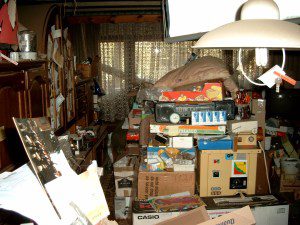 One of the hardest things when clutter-busting can be working out what is really clutter and what isn’t. A great way to decide is to answer 4 simple questions about the purpose of your stuff:
One of the hardest things when clutter-busting can be working out what is really clutter and what isn’t. A great way to decide is to answer 4 simple questions about the purpose of your stuff:
- What purpose does this item have… in my life?
- Could I use something else instead?
- When will I use it?
- Is it expensive / difficult to replace?
To see if these questions can help you, why not give the following clutter-busting method a try?
Choose a Place to Start
Set aside some time for de-cluttering, ideally a good hour or so when you won’t be interrupted.
Start somewhere you haven’t cleared out recently: the more clutter there is to clear, the more satisfying the results! Start with a small area: if you take on too much you could easily end up in a worse mess than when you started. Good examples for me would be the cupboard under the sink, a kitchen drawer, a single bookshelf, or the top layer of stuff in the shed.
You may find you need some containers – big cardboard boxes or something – that you can use to keep the things you’re sorting from getting spread all over the place. Paper and pen might be useful, too, in case you need to jot down a few notes (about things that need mending or anything else that pops into your head whilst you’re working).
Take One Item at a Time
Work systematically through the area that you’re de-cluttering, and consider one item at a time.
For each item…
Answer the Key Question
What purpose does this item have… in my life?
If the answer is, “it doesn’t have one”, set the item aside for disposal.
Answer the First Follow-Up Question
Could I use something else instead?
For example, for keepsakes, this could be a photograph of the item. If you can find a suitable substitute, put the item aside for disposal.
Otherwise…
Answer the Second Follow-Up Question
When will I use it?
If the answer is “never”, put the item aside for disposal.
If the answer is “within the next 12 months”, put the item away where it belongs. If it needs cleaning / repairing, don’t do it now unless you can do it in less than 2 minutes. If you don’t stick to this rule then you’re likely to get distracted, leaving the de-cluttering job half done. Instead, make a note of the extra maintenance task and move on.
So, if you’re not going to use the item any time soon….
Answer the Final Follow-Up Question
Is the item expensive / difficult to replace?
If the answer is “no”, set the item aside for disposal.
Otherwise, put the item away and move on to the next item.
Finally
As soon as you can, get rid of anything you’ve set aside for disposal. As long as it is hanging around, it is still clutter. But once it’s gone…
Acknowledgements
- Picture courtesy Wikipedia.